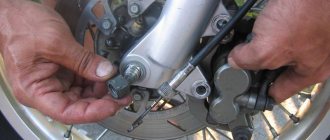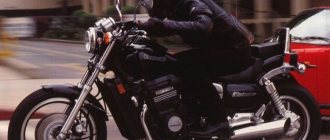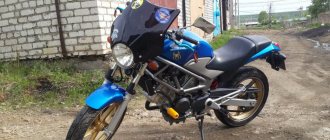000_moto_0412_084
When a motorcycle falls, it rests on the handlebars, engine covers, footrests and muffler.
In this case, when installing a slider, the engine receives additional protection, but the likelihood of damage to the muffler increases. When a motorcycle falls, it rests on the handlebars, engine covers, footrests and muffler. In this case, when installing a slider, the engine receives additional protection, but the likelihood of damage to the muffler increases.
Oddly enough, we do not find any hard protective equipment on road and road motorcycles - as if they never fall at all! Probably, it is precisely because of the seriousness of the consequences that it is not customary to think about them. But it has to. It is impossible to completely protect a road motorcycle or sportbike from damage. But minimizing losses is quite possible. Passive protection means will protect the most important and expensive elements: the engine, frame and parts of the motorcycle chassis.
A classic of the genre for road workers - roll bars. This simple and effective protective element appeared almost simultaneously with the motorcycle and is still in demand today. Classic arches should be screwed to the motorcycle frame and, by absorbing impact energy, protect the protruding parts of the engine from meeting the asphalt. However, on many modern devices the frame is not designed to mount the arches and they have to be installed directly on the engine. And here lies the risk of getting the opposite effect instead of protection. If the arc is too strong, it may tear a piece out of the crankcase upon impact. It's painful and expensive. Therefore, when choosing arches, we pay attention to the places of their fastenings and the design. Let's imagine how they will work if they fall, and, if in doubt, we look for an alternative. It is most reliable and safe when each arch is attached at least at three points. Three-point bars are ideal for modern road bikes and streetfighters. On the contrary, for classics and choppers, the style is closer to the large rectangular arches on the front of the frame.
Unfortunately, bars cannot be installed on all motorcycles. Sportbikes with them look extremely strange, although I have also come across quite original designs. Nevertheless, this is rather an exception and, except for stuntriders, no one installs arches on “sports”. A more common means of protection for sports motorcycles is sliders. Typically made of aluminum and plastic, these frame or engine covers are designed to absorb the load when dropped. Having first appeared on racing motorcycles, they migrated to the streets, changing their purpose. The fact is that professional racers do not care about the condition of the fairings. This is a consumable item that is changed after each fall. After all, compared to a racing engine or frame, even a carbon body kit is cheap. This is why sliders on racing motorcycles usually do not protrude beyond the width of the plastic, and sometimes even hide under it. But the owners of street “sports” are often worried about the condition of the plastic. Because of this, in shops for hobbyists there is always a large selection of funny “mushrooms” sticking out to the sides for a good ten centimeters, on which great hopes are pinned on saving plastics from scratches. The danger here is the same as in the case of arches that are poorly designed. In the event of a more or less serious oncoming impact (for example, an asphalt chip), such a mushroom, like a good lever, pulls out the piece of the motorcycle to which it is bolted. So, by protecting the plastic, you can lose the frame.
My advice: don't get too excited when choosing sliders. Large size is not always beneficial here. Carefully study the method of attaching the slider to the motorcycle (frame, engine). It should not work to break. Here priority goes to parts with wide and thick fasteners. This is typically achieved by adding an aluminum or steel plate between the slider and its mounting location. Sliders are installed in both the axles of the front and rear wheels. They can do a good job of protecting the fork and swingarm from abrasion when in contact with asphalt.
Recently, new slider systems with shock absorption have appeared. Internal elastic element reduces peak loads. The idea is simple but effective, although it significantly increases the cost of the motorcycle. Therefore, I would recommend this design to owners of the top line of sportbikes. On slower bikes, regular ones will suffice. What else can be protected from damage in a modern road construction? Perhaps the fork legs, traverses and steering wheel. When falling, the steering wheel tends to rotate around its axis. Quite a serious torque occurs in the fork legs and in the lower yoke. After all, it is she who, as a rule, has a steering wheel rotation limiter. On racing motorcycles, the role of limiters is played by thick rubber rings placed on the fork legs. The rings absorb the shock and prevent the upper yoke from rotating relative to the lower one, maintaining the correct geometry of both. A conventional steering limiter does not work in this situation. As a rule, any serious fall ends in its breakdown. There are no special rings available for sale, but they can be selected from a selection of rubber parts for heavy equipment.
CNC machining technologies have become widespread in recent years. As a result, very beautiful all-milled caprolon linings for engine covers began to appear. Durable material fits tightly to the motor and reliably protects protruding surfaces. The protection is very effective, but not cheap, so it is available only for real “sports” and expensive street fighters. As an alternative, there are overlays made of carbon fiber. This is also a completely reliable means of protection. When a motorcycle falls, it rests on the handlebars. Therefore, special weight tips are installed at the ends of the steering tubes. They perform two functions at once: thanks to their mass, they reduce vibrations at the ends of the steering wheel and protect the steering wheel in case of a fall. The weights must be securely attached to the ends of the handlebars, otherwise they will not perform their functions. But on the contrary, it is better not to tighten the mirrors and levers all the way - then if they fall slightly, they will turn and, possibly, remain intact.
And yet it is much more pleasant to avoid the fall itself than to reduce its consequences. Strong driving skills, combined with common sense and advanced electronic assistants, reduce the risk of trouble to almost zero. It is a fact. Don't ignore it, and then beautiful sliders or roll bars will turn into another decoration for your motorcycle.
Cases with alarm
These are regular motorcycle covers. But they are fastened from below with a special cable. If you try to open it without using the key, an alarm will sound. The covers are suitable for use in any weather; they are not afraid of water, snow and low temperatures. For greater safety and serviceability, you should also use a regular motorcycle cover. You can purchase a protective case and other accessories on the TENTY.RU website. We have a wide range of cover models in different sizes. Delivery is available throughout Russia.
006_moto_0412_084
The roll bar looks simple, but it is not easy to make.
After the arc has worked (bent), it can only be replaced. Trying to return it to its original geometry is a thankless task. The roll bar looks simple, but it is not easy to make. After the arc has worked (bent), it can only be replaced. Trying to return it to its original geometry is a thankless task.
Motorcycle alarms
There are two types - with feedback and without it. Naturally, the former are much more expensive. It is not recommended to purchase products made in China. The feedback in them is of such quality that it is practically non-existent. By the way, there were cases when it was Chinese equipment that suddenly turned off the motorcycle right on the move.
Signaling devices without feedback are equipped with a siren and shock, swing and tilt sensors. Devices with feedback are also equipped with a special unit that allows you to turn off the engine using the remote control. After this, it is impossible to start the motorcycle with the key until the lock is removed, again using the remote control. In addition, there is a volume sensor. Its purpose is protection by sending warning signals if any object approaches a set distance (usually a meter or two).
Spinal cord injury or spinal injury?
First, let's understand: the spine is 32-34 vertebrae that are supported by discs, ribs, muscles and ligaments. It consists of 5 sections, and the cervical one alone has 7 vertebrae.
In other words, the spine is a fairly “strong” frame in which the spinal cord is located. He, in turn, is a “fragile” nervous tissue with cerebrospinal fluid. According to Dr. Chris Leatt, the spinal cord is “toothpaste in a plastic container.”
Obviously, spinal injuries do not always lead to spinal cord injury. According to statistics from the Leatt laboratory, only every fifth vertebral injury ends in this way. Even so, spinal cord injury can occur without a spinal fracture. Excessive bending of the cervical spine can cause rupture of nerve endings and serious consequences. The cross collar is designed to reduce the angle of neck flexion and reduce the speed of inertial movement of the head. In other words, to prevent these consequences and preserve our health.
In 2000, supercrossman Jimmy Button, during a training run while passing waves, flew over the handlebars and literally “stuck” his head into another obstacle. The impact caused his helmet and head to tilt too far back. He did not use a neck guard at the time and later described it as: “It was like someone had pinched you and you instantly became deaf and cold. Perhaps if I had put on a collar, I would have gotten away with only a headache.” He received a fairly serious injury to the cervical spine.
conclusions
The cost of high-quality neck protection for a motorcyclist (cross collar) in our market starts from $300. This considerable price is determined by the brand, quality, and expensive research. At the moment, this is not a mass or popular product, so the cost of this device is quite high. Many people are very attracted by Chinese copies of well-known manufacturers with an affordable price of $30-100, but for this money we will become the owner of an unknown NONAME and who knows whether this equipment will not cause damage in the event of an accident?
It is quite difficult to collect statistics on spinal injuries in motorcycle accidents, much less draw clear conclusions. Therefore, you have to be content with the information provided by the manufacturing companies of this equipment, and they, like no one else, are interested in selling their products.
Source
Why do this
Two wheels - unstable position. The person operating such equipment must be able to maintain good balance. Any deviation, hitting a stone or bump can lead to loss of balance. The consequence is a fall, accompanied by the motorcycle sliding.
In this case, the first to be damaged are plastic parts, the muffler, the steering wheel, and the surface part of the engine. The higher the speed, the deeper the wounds will remain. Protective devices additionally attached to the bike are designed to prevent this. They are especially relevant for sports models and SUVs.
Neck protection functions for motorcyclists
The primary task of the “collar” is to redirect excess energy, which affects not only the cervical spine, but also other areas of the body. Secondly, the neck protection limits the maximum head tilt angles when the spinal cord injury has not yet occurred, and the rider is still in the process of falling. A good neck guard for a motorcyclist should be able to slow the movement of the head in a controlled manner and, when subjected to extreme loads, break to prevent serious injury to the rider. We will consider real types of loads below.
Blog named after Elessar → Mad collective farm 8: Shovel instead of crankcase protection. Why? Because I can!
Hello friends! I probably already have some kind of collective farm brain... And all because I made the engine crankcase protection from a shovel. And happy.
Laugh, laugh. However, 4mm rail steel, minimum effort, minimum money and maximum profit! Just like a careless Mexican garment factory worker in high heels and a fingernail-length skirt. And for only 450 rubles.
But it all started when I went to choose a gift for February 14th...
Axle load
In other words, this is an unpleasant case when the main blow falls on the upper part of the head. Figuratively: when a motorcyclist flies out and crashes (“sticks”) his head into an obstacle. The impact energy spreads from top to bottom, crushing the cervical spine. Unfortunately, neither the top neck protection from Leatt nor Alpenstars can help with this injury. By the time the helmet makes contact with the collar, serious damage has already occurred. However, neck protection will help with the further distribution of impact energy and limit the movement of the “damaged” spine. Therefore, it is very important to initially move away from the line of impact. To ensure such catastrophic injuries, the rider would need to fall on their head from a height of approximately one meter.
What sports use neck protection?
In motorcycle sports, this type of passive safety has found its application primarily in: motocross, rally, enduro (crossenduro, hardenduro, etc.). In short, in those sports where serious and sharp falls from a height are most likely (for example, from a springboard). However, competition regulations often make this element of cross-country motorcycle equipment optional, i.e. The responsibility for using neck protection rests with the motorcyclist. In demonstration performances, freestyle motocross riders also neglect this element of passive protection. But this is rather due to necessity - during the flight nothing should hinder movement.











